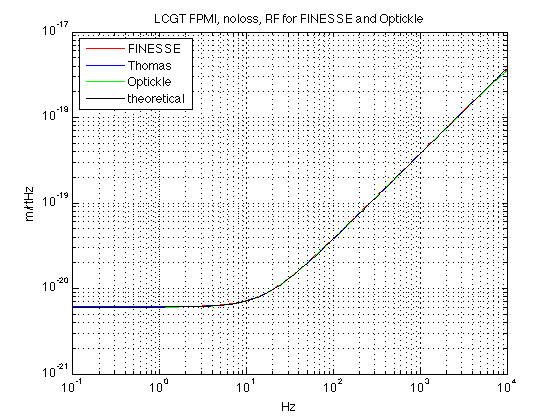|
Size: 1426
Comment:
|
Size: 1602
Comment:
|
| Deletions are marked like this. | Additions are marked like this. |
| Line 20: | Line 20: |
{{attachment:FPMI_noloss.png}} |
|
| Line 21: | Line 24: |
=== PRFPMI no loss case with LCGT parameters === {{attachment:PRFPMI_noloss.png}} [[attachment:20090709_simall_PRFPMI_noloss.zip]] |
Simulation Tools
Name |
Platform |
Domain |
Capabilities |
Author |
Web |
Optickle |
Matlab |
Frequency Domain |
Radiation Pressure, 01 mode |
Matt Evans |
|
Finesse |
C? |
Frequency Domain |
Higher order modes |
Andreas Freise |
|
e2e |
C++ |
Time Domain |
|
Hiro Yamamoto |
Comparison of simulatio tools for LCGT
- Theoretical: just analytical way shown in LCGT document on page xx.
- FINESSE: Developped by Andreas Freise. C based. 'ps2S' and 'scale meter' commands are used for the unit in m/rHz and 'fig' command are used to produce excitations in frequency domain. Compensation factor *sqrt(2) was needed to match other results. This could be a bug.
- Thomas: Developped by Thomas Cobit. Visual C++ besed, running only Windows machine. This is the first simulation tool which can calculate quantum effect including raddiation pressure effect. For shotnoise calculation, just very hevy masses are used to compare shotnoise above.
- Optickle: Developped by Matt Evans. Matlab based, very flexible simulation tool. You can use a full set of Matlab functions. This tool also can calculate full quantum effect.
FPMI no loss case with LCGT parameters

20090709_simall_FPMI_noloss.zip
PRFPMI no loss case with LCGT parameters

